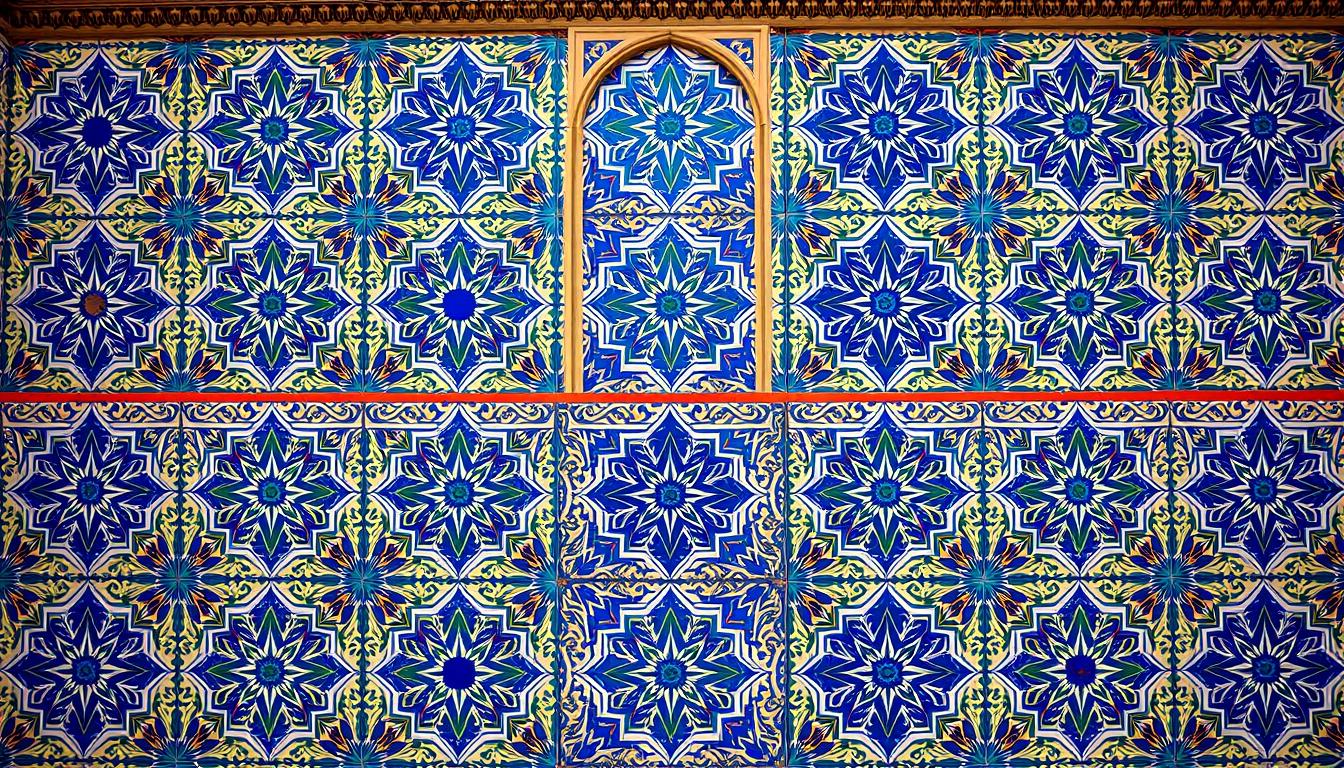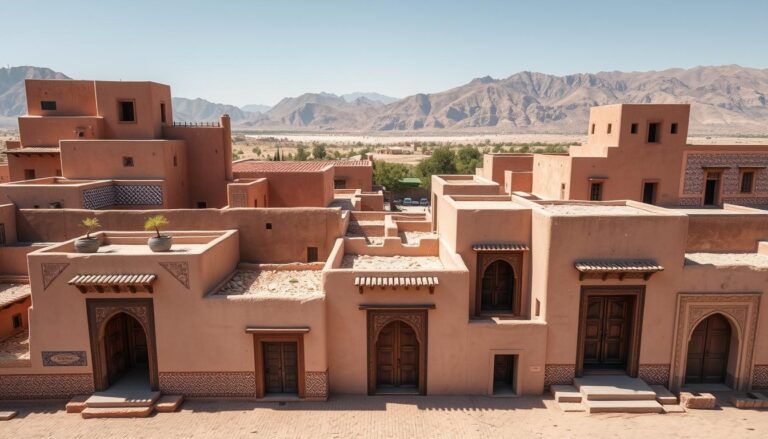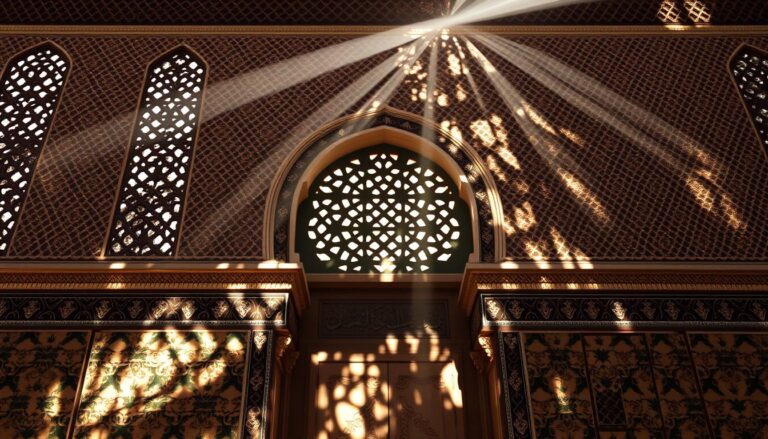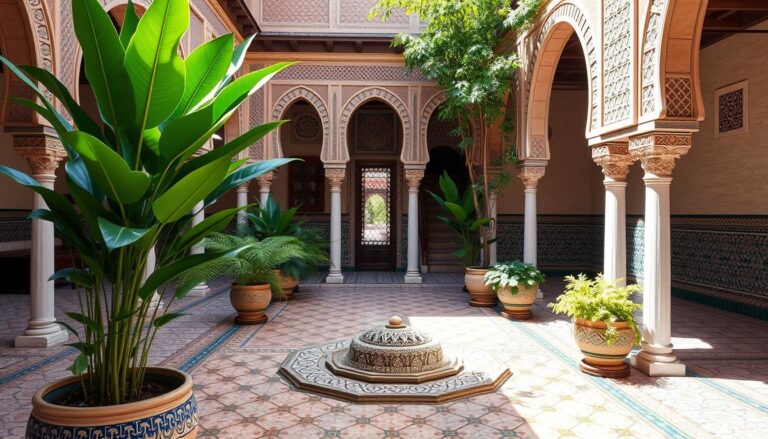Ever wondered about the stunning tilework in Moroccan buildings? This ancient craft, called Zellige or zellij, is a true marvel. It’s a blend of traditional skills and vibrant, geometric designs.
Zellige is a key part of Moroccan architecture. It uses terracotta tiles covered in enamel chips set in plaster. This art form has been around for centuries, adorning mosques, palaces, and public areas. It’s a testament to Moroccan design’s beauty and skill.
Making Zellige tiles is a detailed, time-consuming task. It’s been done the same way for centuries. Skilled artisans, known as Maallems, pass down their knowledge through generations.
Key Takeaways
- Zellige tilework has a rich history dating back to the Roman Empire and the Islamic Golden Age.
- The migration of Moorish artisans from Andalusia to Morocco in the 8th century played a vital role in the evolution of Zellige tiles.
- Zellige tiles are created through a meticulous process involving hand-shaping, firing, glazing, and intricate mosaic assembly.
- Maallems, the skilled Zellige artisans, use traditional tools and techniques to construct complex geometric patterns.
- Zellige tilework has become synonymous with Moroccan architecture, adorning mosques, palaces, and public spaces with its vibrant colors and designs.
The Origins of Zellige Tiles
Roman and Byzantine Influences
Zellige tiles have their roots in the Roman era. The Romans were famous for their mosaic floors and walls. These were made of small, colored stones and glass pieces in geometric designs.
The Romans’ mosaic art spread across the Mediterranean as their empire grew. This laid the groundwork for Zellige’s evolution. The Byzantine art in the Eastern Roman Empire also influenced Zellige’s aesthetic, adding to its beauty.
The Islamic Golden Age
The Islamic Golden Age was a time of great cultural and scientific growth. During this period, Islamic artistic traditions, including mosaic and tile work, thrived. The use of abstract and geometric designs in Zellige tiles was heavily influenced by Islamic art.
Zellige tiles became a key feature in mosques, palaces, and public buildings. They were used to create stunning and symbolic spaces. The Abbasid Caliphate and other Islamic empires promoted the use of geometric designs and Moorish artisans in Zellige tile-making.
“The meticulous craftsmanship involved in creating Zellij tiles is labor-intensive, requiring skilled artisans and techniques passed down through generations.”
The Andalusian tile-making techniques and Moorish influence on Islamic art also shaped Zellige tiles. These techniques and designs were refined and spread throughout the region.
The Arrival of Zellige in Morocco
The Moorish migration of Andalusian artisans to Morocco in the 8th century was key. These skilled craftsmen brought their Islamic art and architecture expertise. They merged their tile-making skills from Spain with Moroccan styles.
This mix created the unique Zellige tilework seen in many Moroccan buildings. It shows the beauty of Moorish and Moroccan styles together.
The Andalusian artisans’ influence is clear in Zellige tiles’ complex patterns. Their skills blended with Moroccan traditions. This created a special tile work that showcases Moroccan craftsmanship.
This cultural exchange made Moroccan art more vibrant. Zellige tiles now amaze people worldwide with their beauty and detail.
“The Zellige tilework technique dates back to the early 10th century in Morocco, and by the 14th century, the color palette had expanded to include green, blue, and yellow. In the 17th century, the color red was integrated into Zellige applications, further enhancing the vibrancy and versatility of this enduring art form.”
Zellige tiles’ arrival in Morocco was a big moment in cultural exchange. The Moorish migration enriched Moroccan craftsmanship. It also left a lasting impact on Morocco’s architecture, inspiring visitors globally.
Zellige tilework techniques in Moroccan Architecture
Zellige tiles are a key part of Moroccan architecture. They show the area’s rich culture and the talent of its craftsmen. This art has been done the same way for centuries.
The process starts with clay molding, done by hand. The tiles dry and then get fired in kilns. They’re glazed with natural colors and fired again.
Next, the tiles are cut into small pieces with special tools. These pieces are put together into intricate patterns. It takes a lot of skill and patience.
The tiles come in a few colors: blue, green, white, black, and red. Each color has a special meaning in Islamic culture. This adds depth to the designs.
The patterns on Zellige tiles show the advanced math and geometry of the Islamic Golden Age. These designs are full of symmetry and shapes. They create a stunning visual effect that has inspired many.
“The Zellige tiles of Morocco are not merely decorative elements, but rather a harmonious blend of art, culture, and mathematical principles that have stood the test of time.”
The Enduring Legacy of Zellige
Zellige is a beautiful tilework found in Morocco’s walls, floors, and buildings. It’s a centuries-old art form that holds a special place in Moroccan culture. This art has decorated the most important religious and royal sites, symbolizing Moroccan identity and preserving its artistic traditions.
Cultural Significance
Zellige in Moroccan architecture carries deep religious and royal meanings. It adorns mosques, madrasas, palaces, and hammams, showing grandeur and spiritual importance. In Islamic culture, Zellige’s patterns and designs avoid showing living beings, instead representing the infinite and divine.
Zellige is key in keeping Moroccan culture alive. Groups and artisans work hard to teach and restore Zellige. They run training programs and fix old sites with Zellige tilework. This keeps Zellige’s art and techniques alive for future generations.
Today, Zellige is used in modern designs too. Designers and architects mix old techniques with new ideas. This shows Zellige’s ability to adapt and inspire, making it a Moroccan architectural gem.
“Zellige is not just a decorative element, but a reflection of Moroccan cultural and religious heritage, woven into the very fabric of the nation’s architectural landscape.”
Conclusion
The art of Moroccan Zellige shows the deep cultural heritage of North Africa. It goes back to the Islamic Golden Age. Over time, Zellige has become a key part of Moroccan identity and a sign of its skill in craftsmanship.
Zellige’s beauty is seen in the hand-cut tiles on walls, floors, and fountains. It’s found in mosques, palaces, and riads. It also fits well in today’s buildings. Each area, like Fassi, Tetouan, and Merinid, has its own style. This shows the mix of cultures in Moroccan architecture and Islamic art.
Zellige’s patterns and colors still amaze people today. It shows the lasting power of Moroccan creativity and its cultural heritage. Keeping Zellige alive means it will keep inspiring people for many years.
Source Links
- From Andalusia to the Almohad: A History of Moroccan Zellige Tile – Design Dash
- Zellij – The Prince of Tiles History | Zellij Gallery
- Spectacular Moroccan Tilework In 11 Buildings
- Historic Origins of Zellige Tiles | Paris Tile
- Cultural Heritage of Zellij in Moroccan Architecture | Paris Tile
- Moorish Tile History and Inspiration – Why Tile
- Zellij
- Provenance: Zellige — CLOTH & KIND
- Morocco’s Traditional Ceramic Crafts: Pottery and Zellige Tilework – Mint Tea Tours
- History and Craftsmanship of Zia/Zellige Moroccan Tiles
- Unveiling the Rich History of Zellij in Morocco: A Timeless Art Form
- Exploring the Art of Zellij | La Signature
- kraftsol
- The Art of Zellige: Exploring the Intricate Tilework of Riad Semlalia – Bienvenue au Riad Semlalia – Maison d’hôtes à Fès, Maroc
- Zellige Styles; Diverse Expressions of Moroccan Art: – Select Crafts Zellige

The Editorial Team is a passionate group of Morocco enthusiasts dedicated to sharing the beauty, culture, and wonders of this captivating country. With diverse backgrounds and a deep love for travel, we strive to bring you engaging and informative content that inspires your Moroccan adventures. From uncovering hidden gems and sharing local insights to exploring mouthwatering cuisine and showcasing the vibrant lifestyle, our team is committed to providing you with valuable resources and exciting stories that enhance your exploration of Morocco. Join us on this journey as we celebrate the rich heritage and unforgettable experiences that make Morocco truly special.







